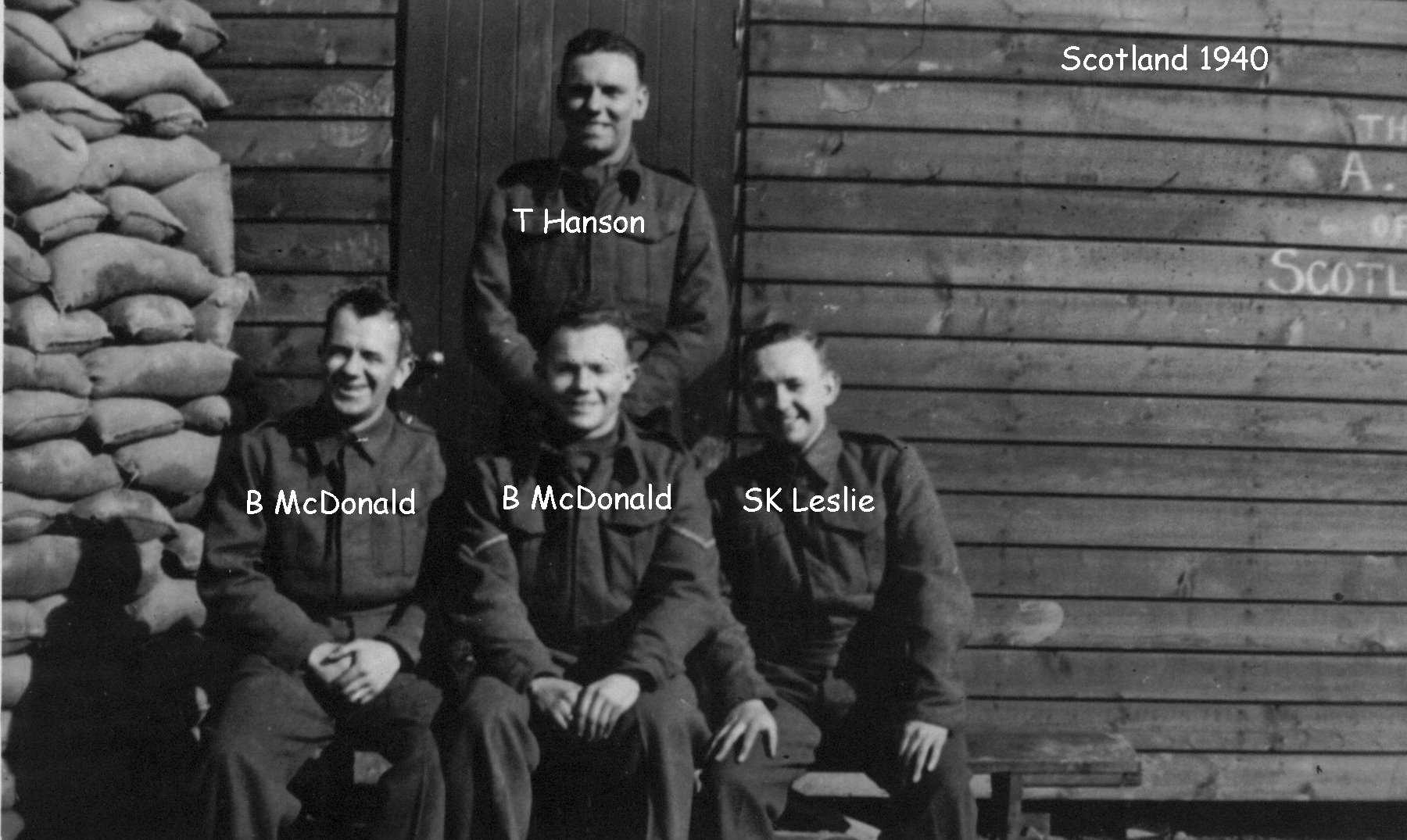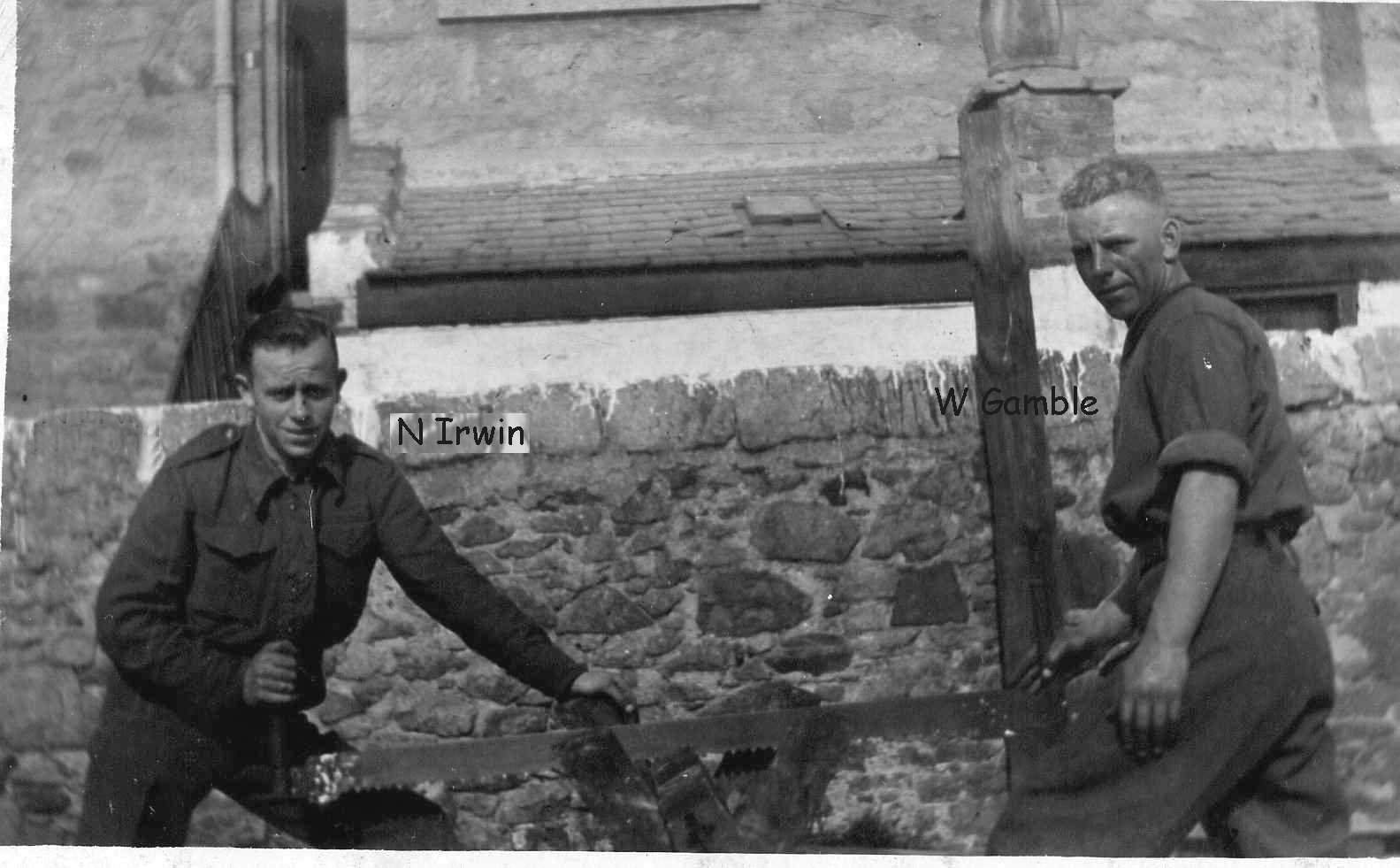

The Coleraine Battery - The Early Years


1939 - 1945
Anti-Aircraft Defence - Scotland On November 9th 1939, the 9th Regiment was split up. The 6th Battery stayed in Northern Ireland and the remainder went to Egypt. This was because the 5th Light AA Battery replaced the 6th. This Battery had been training in England at the time. It has been surmised by many that it was more cost effective to send a unit to Egypt that were already in England and had also completed their Anti Aircraft training. Rommel at Tobruk virtually wiped out the 5th Battery. The survivors were transferred to the Coleraine Battery.
In November 1939 the Battery moved to Scotland, under the command of the 51st LAA Regiment, they covered the AA Defences over a wide area.
"The Battery HQ was located in Falkirk. X Troop were based three miles from Stirling at the Royal Naval Ammunition Dump, Bandeath. When a ship went into Rosyth Dockyard for refitting or repairs, the first thing that happened was that all the ammunition had to be taken off the ship. In Rosyth there were a series of caves used for storing ammunition. these were approached by the use of a railway line. Sometimes the ammo was taken via the Kinkardine Bridge to Bandeath for temporary storage. Bandeath was at least three miles from Stirling. When we were off duty we would walk into Stirling and go to the cinema.
Y Troop were posted to AA Defence duties in Grangemouth. The weapon used in this AA Defence was the Lewis Machine Gun. Z Troop were posted to the Naval Dockyard. There they manned the 40mm Multi Barrelled Pom Pom's". Robin Martin (2004)
X Troop's Itinerary for Scotland and The Move
|
Move |
Date |
Location |
|
1 |
Dec 1 - 9 1939 | Westbourne Cottage Cambuslang Glasgow |
| 2 | Dec 10 1939 | Royal Navy Ammunition Dump Bandeath Stirlingshire |
| 3 | Jan 25 - Feb 12 1940 | Rechabite Hall Grangemouth Stirlingshire |
| 4 | Feb 12 - March 20 1940 | Royal Navy Ammunition Dump Bandeath Stirlingshire |
| 5 | March 20 26 1940 | 129 Coy, Royal Army Service Corps The Dean Orphanage Bulford Road Edinburgh |
| 6 | March 27 - April 8 1940 | Royal Navy Ammunition Dump Bandeath Stirlingshire |
| 7 | April 8 - 15 1940 | Hallhill Camp Ballieston Glasgow (Leave from April 15-23). |
| 8 | April 24 - May 12 1940 | Crombie Farm Crombie Fifeshire |
| 9 | May 12 - June 6 1940 | Hallhill Camp Ballieston Glasgow |
| 10 | June 7 - 29 1940 | Mid Netherton Carmunnock Glasgow |
| 11 | June 30 - July 15 1940 | Southhook Potteries Kilmarnock Ayrshire |
| 12 | 16 July - 29 July 1940 | The Hostel, East Bridge St Falkirk Stirlingshire |
| 13 | July 30 1940 | Mid Netherton Carmunnock Glasgow |
| 14 | August 1 - 23 1940 | Old Academy Dingwell Rosshire (Leave Aug 15 - 22) |
| 15 | August 23 - 25 1940 | Mid Netherton Carnmunnock Glasgow |
| 16 | August 26 - 30 1940 | Anti Aircraft Practice Camp Cark Lancashire |
| 17 | August 31 - Sept 9 1940 | Minley Camp Aldershot Hants then Farnborough |
| 18 | Sept 10 1940 | Liverpool Docks - Dominion Monarch - sailing for Egypt |

Some of the first tasks for the Battery in Scotland included the protection of a four-mile square ammunition dump at Bellshill. This was located SW of Glasgow. They were also responsible for the AA Defence the large petrol tanks at Grangemouth. Both these were precarious assignments because there would have been no escape if an enemy bomb had dropped on either location. Y Troop was tasked to well secluded gun posts around the city of Aberdeen. It was here that Sgt. Andy McGowan is credited with shooting down the Battery's first plane, a German Dornier 217, with a Lewis machine gun. The plane crashed into Aberdeen Skating Rink, which was empty at the time. The crew had parachuted to safety and Gunner Jack Doherty retrieved the pilot's gloves as a war souvenir. (Speedy Moore, 2004)
"There was twelve of us posted to the Lewis Gun Pits just outside Aberdeen. Sgt Jimmy McCaw was in charge of our group. The Lewis guns were in two pits. Each pit had a pole with the gun mounted on it. These Gun Pits were on the Douglas Farm on Torry Point, facing out into the North Sea. Our task was to protect Aberdeen City and the harbour by interdicting the German planes as the came in from occupied Europe.
Mrs. Douglas was a small lady, always neat and tidy. She had lost a son in the war. He had been a fighter pilot from Aberdeen University. She also had another son and two daughters. One day she presented us with her late son's wind up gramophone and his collection of records. We always found the Aberdonians were a generous and welcoming people.
One day we got the order to stand to. There was a heavy fog on the coast and we could hear the dog fight in the sky directly overhead. John Hutchinson was my No. 2 on the gun, responsible for the reloading when necessary. The rules were that we had to wait for the Sgt. to give the Fire Control Orders before opening fire. Jigger Diamond was on the other gun. Both of us had limited arcs of fire so that we only engaged targets when it was safe to open fire. If we fired outside our designated arcs, we were in danger of shooting each other.
.
It came out of the fog to our right. It was like a double decker bus. I never thought about Jimmy McCaw. I had the gun cocked so I got stuck into the plane. When it moved to the left, I kept firing even when I moved out of my safe firing arcs. John Hutchinson reloaded the gun when it emptied. The plane was easy to shoot because the magazines were loaded with a two ball and one tracer sequence. You just hose piped the rounds onto the plane, once you were on, you kept it there." Spanky McGowan (2004)
  |
|
In 1939 Bobby McDonald used his father's railway note book to write up his lesson plans on the Lewis Gun |


Y Troop at their Aberdeen Accommodation



Dodger McKeown and Company at Grangemouth
During this period in Scotland, the Battery also endured over one month's intensive physical training. At 6am the Battery would parade, face washed and without breakfast, for a bout of cross country running and Physical Training (PT). By 9am the Battery were expected to have washed and had their breakfast. Then they embarked on another bout of Marching Drill and PT until lunchtime.
After lunch there was another bout of Drill and PT until 5pm. There was a short respite for an evening meal and then further Drill and PT until 9pm. What was the purpose of all this training? Was the Battery getting prepared for a special mission? No, they were in training because they needed it.
After the Scottish posting, the Battery went on leave from August 15th until 22nd 1940.
With a well-earned rest, the Battery then went straight into Bofors Gun training on the English Artillery Ranges. First stop was the Practice Camp at Cark, Lancashier from August 26th until 30th. Second stop was Minley Camp, Aldershot Hants, from August 31st until September 8th 1940. From Minley, the Battery moved down to Farnborough and were fitted and kitted out for the Far East.



On the night of September 8th, 1940, the Battery left Farnborough in the middle of an intensive bombing raid. They were heading for Liverpool to board the MV Dominion Monarch.
| Battery Roll Call |